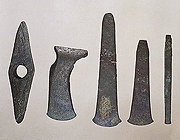The Early Bronze Age in the Helladic region
covers roughly the period 3200-2100 BC.
The main characteristic of this period is the intensification of the use of metals
and particularly the extension of metalworking by the mixing of copper and tin
for the manufacture of tools and weapons of durable brass (bronze).
This brought about the improvement of the Neolithic agricultural and animal husbandry
economy, the increase of production, the creation of surplus of goods and the
development of productive activities. The quest for metals and other raw materials
as well as the necessity of promoting exchangeable goods led to the intensification of
commercial contacts, the development of navigation and the exchange of
technological and cultural experience.
The beginning of the use of metals (gold, silver, copper) for the
manufacture of jewellery and tools dates to the Final Neolithic Age which is
named Chalcolithic (4500-3200 BC) for this reason.
The transition from the Neolithic
agrarian economy to the Bronze Age is not abrupt and does not occur at the same time
in the various geographic areas of the Aegean.
In addition every area is ruled by different geomorphological factors and forms its own
cultural character.
On mainland Greece, three large cultural groups are distinguished
during the Early Bronze Age. These are developed in Thrace and Macedonia, in Thessaly and
in the central and southern mainland. The 3rd millenium in central and southern Greece
which is known as the Early Helladic period
is of particular importance for the Aegean Prehistory.
The Early Helladic period is distinguished in the following chronological-cultural
phases: Early Helladic I (EH I), Early Helladic II (EH II),
the transition phase Lefkandi I-Kastri and
the Early Helladic III (EH III) period.
The traits of this period are:
the increase of population which is proportional to the increase of settlements in coastal
areas or in the inland, the remarkable town planning, the increase of production and
surplus of produce, specialization, the technological development (metallurgy, pottery)
and industrial production, the control of the goods' distribution (use of seals),
the intensification of commercial exchange and the increase of privilege goods.
During the EH II period a particular economic prosperity
is observed with direct effect on the social and political organization of the settlements.
In Thebes, Manika, Aegina, Tiryns, Lerna and other places, densely populated settlements of an
urban character are developed. This trait is apparent in the town planning,
the community buildings ("Corridor Houses"),
the constructions of public interest (fortifications),
the technological specialization, and the particular economic-administrative
importance in their greater region (regional hierarchy).
|
 |